Spyware Cases (Part 2)
Continuing the topic of spies, espionage and their sometimes fantastic devices, one cannot help but highlight such high-profile events related to wiretapping of the US Embassy with tips (1945-1952), wiretapping of the Soviet embassy in the Netherlands, the Pueblo incident.

1960 year. After the incident with U-2 at the extraordinary session of the UN General Assembly, the American side demonstrated a listening device, which for 8 years was successfully “located” in the Moscow office of the US ambassador and was hidden inside a wooden copy of the Great Press of the USA.
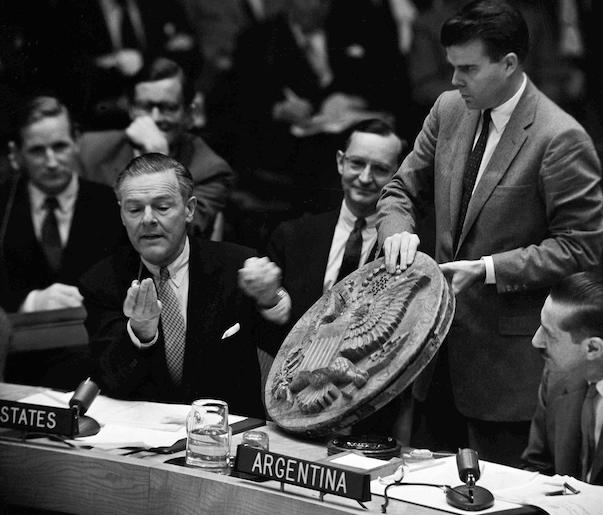
')
The secret bug did not contain any electronic components and did not require batteries or any other power source. Americans christened the bug - the Thing. From the Soviet side, the wiretapping operation was codenamed “Confession”, and the implementation was called “Chrysostom” and was supervised by Stalin and Beria.
The Thing / The item, also known as The Great Seal Bug (a bug in the Great Seal of the United States), was a passive secret wiretap device developed in the Soviet Union and successfully hidden in the office of the American ambassador in Moscow. It was hidden inside the wooden replica of the Great Seal of the United States. Why is a passive device? It worked without its own power source, activated by strong microwave radiation outside. In the US, the device was code-named "LOSS".
For 10 years, the Soviet side carried out painstaking work on the plan to introduce a unique bug. And on August 4, 1945, at the celebration of the 20th anniversary of Artek, the All-Union Pioneer Organization named after Vladimir Lenin presented the United States Ambassador Aveller Harriman a wooden copy of the Great Seal of the United States as a symbol of friendship between the allies in World War II. The coat of arms was hanged in the residence of the American Ambassador Spaso House (Spasopeskovskaya playground).
Unknown to Americans, the bug, hidden in the engraved coat of arms, was a high-frequency radio transmitter of the original design: there was no own power source, there were no connections and wires. Instead, the device was driven by a strong radio signal from the outside. Such a resonator with an unlimited duration served the Soviets as the best intelligence service.
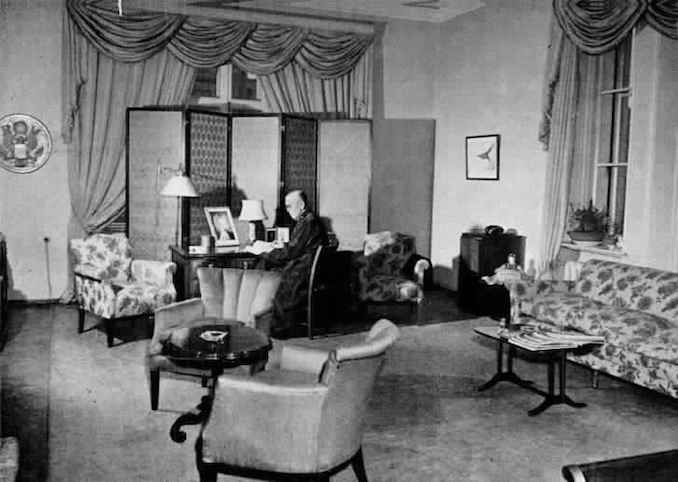
Beginning in 1945, after the Amerasia case, the United States was suspicious of security in embassies abroad, especially in Moscow. Although at the end of 1940, quite a few listening devices were found in the US embassies in Eastern Europe, none of them were found in Moscow, beginning in World War II. Nevertheless, diplomats believed that ears had grown on the walls in Moscow. Suspicions intensified in the fall of 1951.
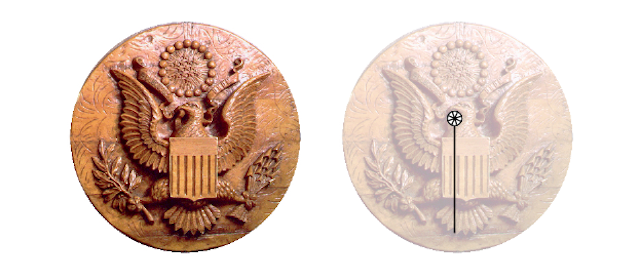
Official version. In 1951, a British radio operator at the British embassy (located 700 meters from the US) watched the Soviet radio connection, when he suddenly intercepted a conversation in which he recognized the voice of the British aviation attaché, but the search at the embassy was not found. Another situation occurred with the American cameraman in 1952, when he accidentally stepped on the LOSS frequency and was able to overhear the conversation, which, as it turned out, was based on the ambassador’s residence at Spaso House. An intensified search for listening devices began. As a result, the bug was discovered with the help of a so-called crystal video receiver, just during the Soviet NKVD interception.
The bug was discovered by the US State Department in 1952 during the time of George F. Kennan, during which time three ambassadors managed to change posts. What they just didn’t do and how they didn’t look for a source of information leakage: the embassy employees were interrogated with a lie detector detector, they shoveled every centimeter of the embassy itself, but to no avail. How did you manage to find Chrysostom in the safe “walls” of a wooden vault? There are several versions: the cessation of information leakage was noticed at the time when the emblem was removed for restoration; cracked wooden coat of arms gave the location of the bug, being in a crack; there was a certain "well-wisher-traitor" Lieutenant Colonel of the GRU Pyotr Popov, recruited by the CIA, sharing secret information.
The crystal video receiver, as the name suggests, consisted of a crystal detector and a video amplifier, the noise level was set by a crystal detector.
The device found inside the coat of arms presented the gaze of Americans in the form of a cylindrical microphone with a wire about 23 cm long, which is interesting, without any batteries. Initially, even there was an assumption that the real bug was hidden in another place, and this is only an unknown thing - The Thing. For another year and a half, American intelligence engineers fought a mystery - what is it? The bug was located under the beak of the eagle, tiny holes made in the tree, sent sound to the membrane. After a successful operation to introduce the device, the Soviet services bought 2 apartments in the building opposite, the residents were immediately evicted and the NKVD employees were accommodated. Thus, Stalin learned about the decisions of Americans before the President of the United States.
The American side decided not to publicize such an unexpected discovery, until the U-2 incident in 1960. On May 1, 1960, an American U-2 spy plane was shot down over the airspace of the USSR. A meeting of the UN Security Council was convened, at which the councils accused Americans of espionage. On the fourth day of the meeting (May 26, 1960) the fact of mutual espionage between the two countries was highlighted: the American ambassador Henry Cabot Lodge demonstrated the Trojan coat of arms.
The Thing is a so-called resonant hollow microphone (consisting of a resonant cavity + a condenser microphone). The diagram below shows the construction of The Thing, compiled from various reports and publications.

The silver-plated copper cylinder was a high-quality, reentrantable resonator. In the center there is an adjustable disk-shaped element with a flat surface, which, in combination with a very thin membrane of 75 microns, forms a cavity. The antenna entered the cavity through an insulated hole on the side of the cylinder.
The diameter of the cavity length of 17.5 mm was 19.7 mm, the length of the antenna - 22.8 cm (9 inches). The thickness of the membrane on the front of the cylinder was only 75 microns. Known as endovibrator.

Any sound in the room, such as speech, made the membrane vibrate, which reduced or increased the space inside the cavity, as well as the space between the membrane and the disk-shaped element. As a result, the bug created a combination of amplitude modulation (AM) and frequency modulation (FM).

Receiver overload could be solved by using a directional antenna. To increase the power of the antenna, a 3-pin receive / transmit switch (circulator) was added.

The resonant hollow microphone was patented by Winfield Koch at RCA (Radio Corporation of America) in 1941, while the Soviet bug Zlotoust was developed by Leon Theremin (August 27, 1896 - November 3, 1993). Born in St. Petersburg, the inventor, first of all, he is known as the creator of the electoral music instruments. Theremin or theremin - his brainchild - is a musical instrument with a contactless sensor. During the movement of the hands, the capacity of the oscillating circuit of the instrument changed, which affected the frequency. By the way, you can buy such a tool today at auctions, the price is from 7 thousand dollars.
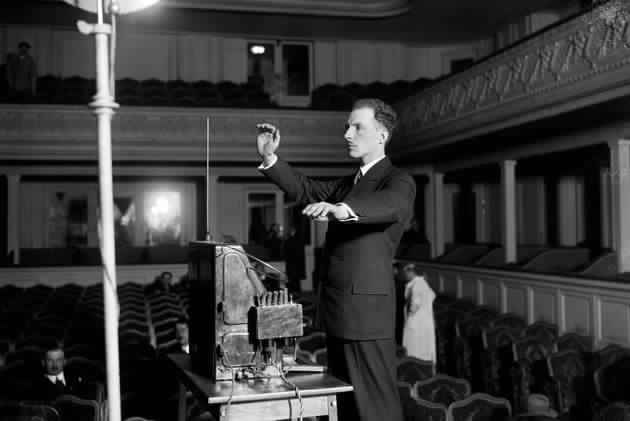
Theremin lived in the United States since 1927, according to the official version, the councils sent him on a business trip in order to demonstrate what the “technician reached”, although the real purpose of his stay in the United States was espionage. Until 1938, he lived in New York, was known as an extraordinary person, he even married the example of the First American Negro Ballet, for which he paid the loss of many friends and acquaintances, received condemnation in society. He was almost the most popular man in New York, even was listed in the club of millionaires. In his studio worked Albert Einstein, conductor Leopold Stokowski, Charlie Chaplin, Marie Helene Bute and others.
In 1938, due to financial difficulties, he was forced to return to the USSR just before the Second World War. Although there are still versions: according to one, the reason for returning home was his sense of responsibility for his homeland during the impending war; according to the second, the NKVD forcibly removed the inventor.
American friends and acquaintances believed that Theremin disappeared without a trace. The West was convinced that the inventor of the Theremin is dead. Paradoxically, in the USSR, Termen was convicted on suspicion of espionage for 8 years in camps, imprisoned, and later sent to Sharashka, where he served time along with other detained scientists and engineers, such as Andrei Tupolev and Sergei Korolev. There he was engaged in the development of the Buran listening system, The Thing and other devices for the NKVD. In 1947 he was released, and in 1956 he was fully rehabilitated. Until 1966, he continued to work in the NKVD (by that time, the KGB), and after leaving the bodies he was engaged in teaching activities at the Moscow Conservatory, until a journalist from the New York Times published an article about Termen. There was a noise, a sensation "There is life!", As the outstanding inventor was considered long dead. Invitations rained down from all over the world, but it was not there. Instead of fame and recognition of his birthplace, Termen "got" a dismissal from work, his designs were simply thrown away. This is how Termen's synthesizer did not see the light, on which Lev worked painstakingly, which was successfully developed later by Yamaha. He died in 1993 in Moscow at the age of 97 years in poverty in his communal apartment near the Cheryomushkinsky market.
So, after the American U-2 spy plane was shot down over the airspace of Soviet countries on May 1, 1960 (U-2 incident), the Americans decided to open a Soviet listening device called the Western country The Thing / Item that was found in the residence Ambassador to Moscow 8 years ago. Thus confirming the fact that espionage was mutual. Listening device Zlatoust attracted the attention of the international press; over the next days and weeks the headlines about Thing were full on the front pages of newspapers.
There were rumors that the United States did not know how the device worked, and even turned to the UK for help. However, there is a sufficient amount of evidence from official reports about the absence of ignorance on the part of various American agencies: they studied the device and well understood the principle of its work.
The following agencies conducted their own investigations: the US State Department, the FBI, the US Naval Research Laboratory, the NSA, and others.
Although many agencies claim to be involved in the discovery of The Thing, the device was actually found by the State Department (DoS) during an organized secret security check in September 1952. Although endovibrators were already known, they had never been used as listening devices before.
The next day, the find was sent to Washington (USA) and transferred to the FBI for further investigation. Information obtained as a result of studies of the bug, was later used to train various agencies.
As mentioned earlier, the first device research agency after its discovery by the State Department was the Federal Bureau of Investigation (FBI). Determining the operating frequency of the device was not easy, because the FBI equipment was not suitable for frequencies above 400 MHz. Fortunately, the FBI was able to borrow the following test equipment from the National Bureau of Standards (now: NIST) for one day. Important findings of the preliminary study were as follows:
One of the first organizations that were involved in the investigation, in addition to the Ministry of Defense and the FBI, was the Naval Research Laboratory (NRL), it worked closely with the FBI during a technical investigation. To avoid “duplication” of efforts, the NRL was ordered to develop a counter-receiver that could detect resonant microphones. The laboratory was supposed to provide a working prototype of such a device. On December 1, 1952, the FBI / NRL Final Technical Report was prepared. It was a report on the analysis and experiments conducted by the laboratory and the FBI, detailed large-scale drawings and photographs, an NRL report with schemes for developing equipment for detecting such listening devices.
Since the USSR was the first to use such listening devices, there was a clear understanding that in case of detection of resonant microphones they would be copied by Western agencies and that sooner or later they could be used against them themselves. Therefore, the Soviets developed their own countermeasures.
An example of a receiver that was specifically designed to detect resonant microphones was OSOBNJAK 8.
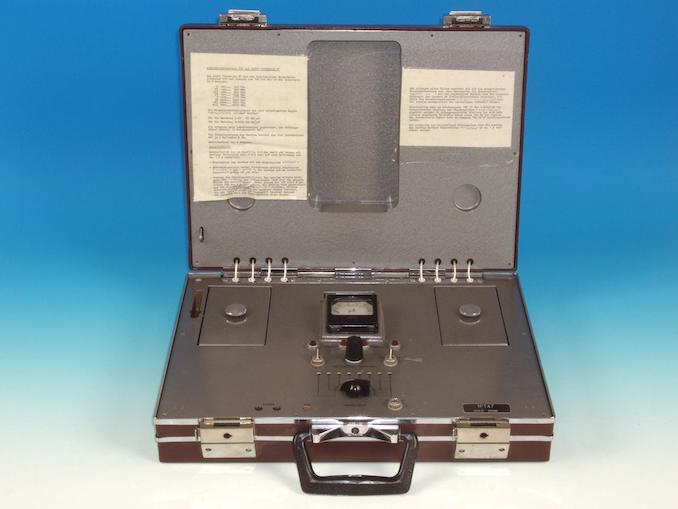
The device was located in an unobtrusive diplomat and could detect strong near radio frequency signals from 100 MHz to 12 GHz; signals that are commonly used to activate such microphones. The device is also known under the code 1RTA7. The device was powered by rechargeable batteries, which provided approximately 4 hours of battery life.

OSOBNJAK 8 is an example of a device for detecting Malware and similar devices. It is an indicator of field strength (could detect adjacent radio frequency signals between 100 MHz and 12 GHz), divided into 8 frequency bands, each of which has its own antenna. The antennas are hidden inside the case cover, the opening angle is about 90 °. The dimensions of the diplomat made it possible to easily transfer OSOBNJAK 8, take on important meetings, install in every office where important meetings with foreign guests took place, and the device was quite simple to use, and any strong RF microwave signal was immediately detected. With OSOBNJAK 8, it was impossible to determine from which place the radio signal was activated. In order to find where the signal was coming from, we needed an aperiodic receiver for the intended band, plus an antenna with a narrow viewing angle.

A suitable solution is the MRP-4 radar, which was developed in 1972 by Tesla (Czechoslovakia). This device could be carried in a bag, the antennas were directed forward. Although it was originally designed to search for radar stations, it could also be used to detect any nearby strong transmitter. In addition, it could be used to detect weak pulse transmissions from radar and signaling devices.
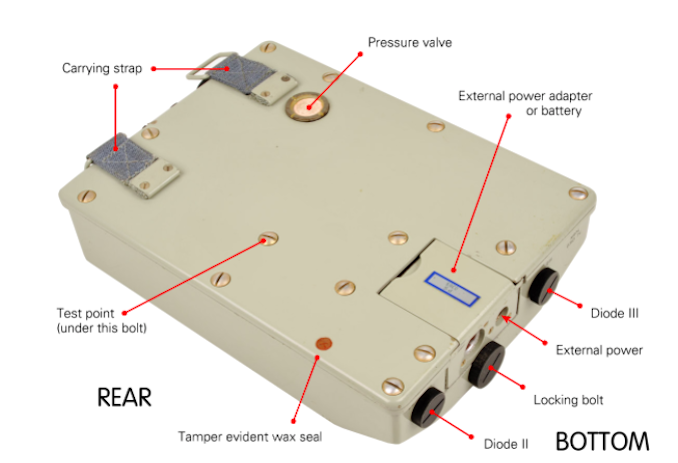
Antennas MRP-4 had a narrow viewing angle, usually from 1 to 2 degrees, the device was suitable for the frequency range of 1 - 10 GHz, divided into four bands. Similar devices were developed in the USSR.
After the discovery of The Thing in 1952, the CIA began its own research program and development of secret transmitters of this type. In 1965 it was developed
a similar device - a resonant microphone, similar to the Soviet The Thing, activated by a pulse signal.
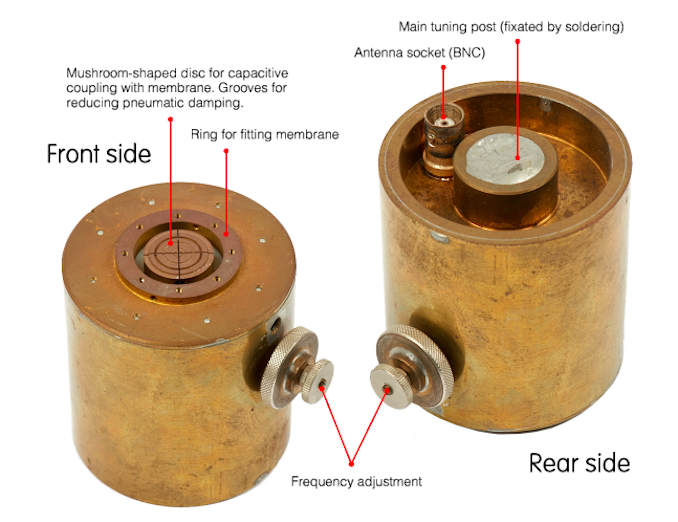
In 1958, during a joint secret operation of the Central Intelligence Agency (CIA), the Netherlands Internal Security Service (VD) and the Dutch Radar Laboratory (NRP), an attempt was made to deploy a secret listening device (bug) in the office of the Russian ambassador in The Hague (Netherlands) . The operation was called "Easy chair" / Easy hair (EC).
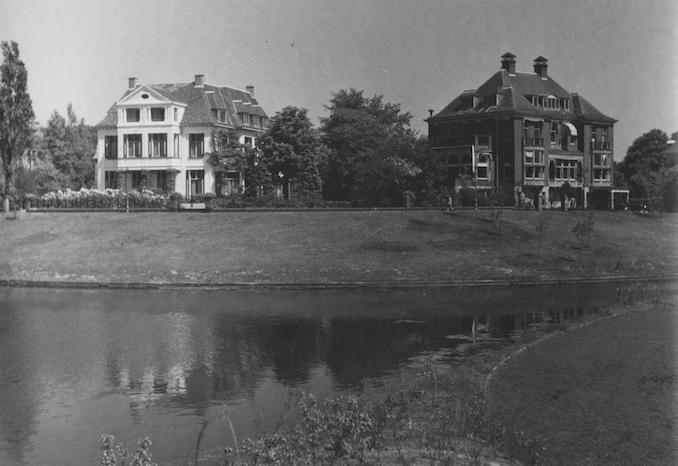
In the early days of the Cold War, both the Dutch Security Service (BVD) and the American Central Intelligence Agency (CIA) regularly conducted secret operations against members of the USSR, and observed Soviet satellites operating in the Netherlands. Since the CIA conducted secret operations in the guest country, it was decided that every action would be taken only with the permission of the BVD.
At the end of September 1958, the BVD reported that the councils ordered new furniture for their embassy in The Hague through the National Procurement Bureau. This chance does not happen often: the opportunity to install listening devices just in the furnishings.
The Dutch BVD developed a plan for installing the Easy Chair (EC) device / Easy Chair - these were manufactured by the Dutch Radar Laboratory (NRP) in Noordwijk (Netherlands) for a top-secret CIA project directly to furniture. So, special attention was paid to the table, since it was intended in the office for the ambassador himself and could in the future show all his “potential”.
On Saturday, November 22, the table was almost ready, it only remained to polish it. This was the perfect time to install the bug, so it was decided that BVD would install the EC the next day, Sunday 23. The next morning, at 11:00, the internal security service of the Netherlands got access to the workshop. The table was turned over, and the bug, without noise and dust, was installed in the left rear corner.
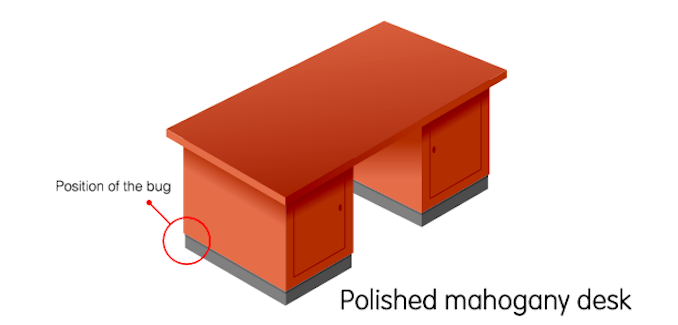
The table was varnished a few days later on November 26, on the same night the BVD operative had to make a small hole 1 mm in diameter again for the microphone, which was blocked during the lacquering. He tested the device, the sound quality was not perfect. A day later, the bug was checked again, the delivery of the table to the embassy was scheduled for December 10, 1958. Meanwhile, the interception point was placed at the observation post Zorgvlid.
Zorgvlid is a fairly tall building, which was located about 125 meters from the front of the USSR Embassy, on the other side of the canal. Although the building was located two streets away from the embassy, the entrance and the front side of the observed object were clearly visible from it.
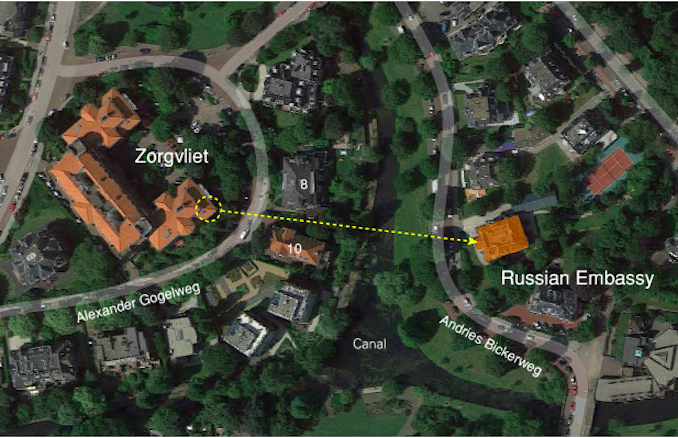
A few years before these events, the BVD acquired a small room in the attic of the Zorgvlid building, it was monitored, and photo was monitored for those who entered or left the USSR Embassy. Since a clear view of the target building opened in the attic, it became a suitable place to install the Easy Chair antennas. The satellite image shows the position of the observation point Sorgvlid (1958). The interception post was located in a very small room in the eastern corner of the attic, the observation deck was located in an uninhabited part of the building. Behind a few forgotten doors was a small utility room with a narrow staircase, the staircase led to the hatchway, which served as the entrance to the real room for interception. 5 windows of the room (the square of the room approximately 5 x 3 meters) went straight to the Soviet embassy.
Today, the observation post is no longer used. The room is empty, and the view of the embassy is covered with trees. Nothing in the room is any more reminiscent of what happened in its walls during the Cold War.
The images below show how and where the Easy Chair (EC) listening device was built into the furniture. A large mahogany table was ordered to the Soviet embassy, which, most likely (as it was calculated) for the ambassador himself. There are two deep lockers in the table, in each cabinet there are three drawers, closed by doors. The total height of the table was 76 cm. The table was set on a pedestal with a height of 10 cm.

Since the design of the 10 cm pedestal was separated from the main part of the table, it was decided to install a bug in the rear left corner of the table, while a tiny hole with a diameter of 1 mm was made for the microphone, about 6 cm above the pedestal.


A few days after the new furniture was delivered and installed at the USSR Embassy, BVD operatives tried to activate the EU bug, but without success. Presumably, the distance between the target and the interception point was large, or the device was detected.
To check the device at a shorter distance, a truck with a tarpaulin was sent under the embassy, and allegedly something happened to the engine in front of the embassy itself. It was parked in front of the embassy, and under a tarpaulin there was hidden a 40 W transmitter and a battery-powered receiver.
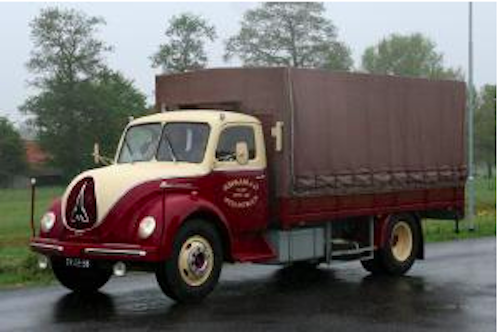
The devices were controlled by field engineer NRP Hextre and the CIA operator, they were in the truck. The antennas were turned toward the embassy, and the transmitter was turned on. After tuning the receiver, after a while they managed to catch the signal of the Easy Chair bug. The first thing they heard was a loud and clear laugh. ES worked and was not detected by the tips. This meant that for the LP antennas the distance from the building where the wiretap was conducted and to the embassy was large.
Two new antennas were developed, each 2 x 2 meters in size and providing a gain of 20 dB, in addition, the isolation between the transmitter and the receiver was improved.
Every day field engineer Hekstra conducted experiments in the attic of the apartment Zorgvlid. His research findings were handed over to Gerhard Prins at the NRP, which took up the improvement of Heckstra's development, and soon after a series of improvements and solutions to EU problems could be reliably activated from the attic.
The operation lasted about six months, after which the bug was discovered by the councils, or perhaps in the attic of the embassy they made a soundproof room.

Easy Chair (EC) is the name given to a top-secret research project conducted by the Dutch Radar Laboratory (NRP) to the order of the US Central Intelligence Agency (CIA). Easy Chair began to be called a series of secret listening devices (bugs), who saw the world as a result of this study. EU devices are passive devices, they did not need a local power source, such as a battery.
Instead, EC devices were energized from a strong radio frequency (RF) signal transmitted to it from a nearby wiretap point. By the time the tapping operation of the Soviet embassy was underway, the EU was already in its third “incarnation”, using the passive element of the EU III (PE). It is shown in the image below.

Like the previous EC I and EC II, the system ran at 378 MHz, but offered sound masking using a frequency-modulated subcarrier. A new passive element (PE) located inside the antenna was also applied. Thus, the device was improved in terms of secrecy, in earlier EC I and EC II, the signal (in the case of scanning) could be accidentally intercepted.
EC III was one of the first attempts to implement the principle of improving secrecy, known as sound masking. The passive element represented a virtually open vibrator with a length of approximately ½λ. Unlike PE EC I, this version did not need an external amplifier, since its electronics were built into the vibrator. All parts of PE, with the exception of the microphone, were embedded inside the antenna itself.
In addition, PE was suitable for connecting almost any type of high impedance microphones, in the case of the 3-wire version even low impedance microphone was suitable. Another microphone that was used with the EC III and later models was the so-called miniature Type-B. It is based on the RCA BK-6B studio microphone, which was placed in a special case (developed by the CIA).

During the Cold War, the Russian embassy in The Hague, as is known, was engaged in espionage, but everyone worked under the cover of diplomacy. Most of these "diplomats" constantly followed the BVD. In February 1958, three Soviet diplomats were even expelled from the Netherlands. Five NRP employees (a small Dutch company developing equipment) worked directly on the “Soft Chair” operation and subsequent CIA projects. Not the fact that they all knew that their customers are American intelligence services. Moreover, even the Dutch special services did not know about the amount of cooperation between the CIA and the NRP.

Russian Embassy in The Hague (formerly Soviet Embassy)
Information about the operation Easy Chair / Easy chair, which opened completely by accident, shed light on the role of the Netherlands in the Cold War. Maurits Martine (a journalist) conducted an investigation three years long after the grandson of one of the participants in a secret operation had found his grandfather's notes about the CIA and the research being conducted. Cooperation between the NRP and the CIA continued until the 1990s.
USS Pueblo, also known as AGER-2, was officially a Banner-type hydrographic ship, but in fact it was a Cold War scout and was owned by the US Navy as a information gathering ship (spy ship). He was attacked and captured by North Korean forces on January 23, 1968, after which secret intelligence equipment fell into the hands of North Korea and the USSR. This event is known as the incident that occurred between North Korean patrol ships and the American vessel Pueblo in the territorial waters of North Korea on January 23, 1968.

Reconnaissance vehicle AGER-2. May 13, 1967
On January 5, 1968, Pueblo left the US naval base in Yokosuka (Japan) with the intention of collecting information about the Soviet "red" fleet and North Korea as part of a secret mission with SIGAD USN-467Y, jointly conducted by the US Navy and the US National Security Agency (NSA). For radio contact, USS Pueblo used the call sign Navy on a call to NGVE (November Golf Victor Echo)
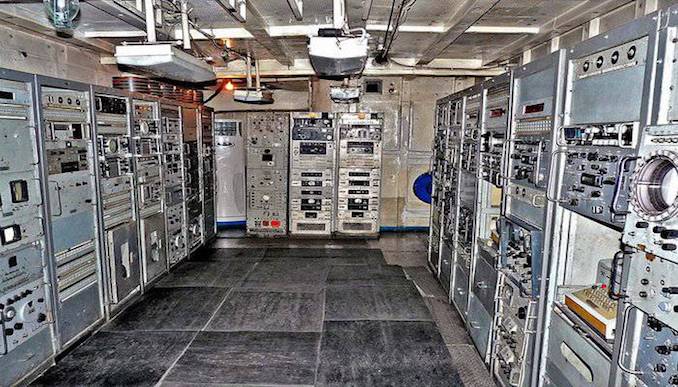
On January 22, the ship passed near the North Korean port of Wonsan under harsh radio silence. It was an exceptionally sunny day, the scout quietly moved south along the coast of the Korean Peninsula, collecting information about radio sources simultaneously. After lunch, however, luck turned his back on him; Pueblo was spotted by two North Korean fishing trawlers. The crew decided to break EMCON 3 in order to send a message to SITREP-1, 4, but due to poor ionospheric radio communication, the attempts were unsuccessful.

The next morning at about 10 o'clock SITREP-1 was successfully sent. Shortly thereafter, SITREP-2 was sent, indicating that the vessel was no longer under surveillance, but this was not the case. By lunchtime, a North Korean submarine rapidly approached AGER-2, S0-1 was on the way. Soon, three P4 torpedo boats and two MIG-21 fighters joined.
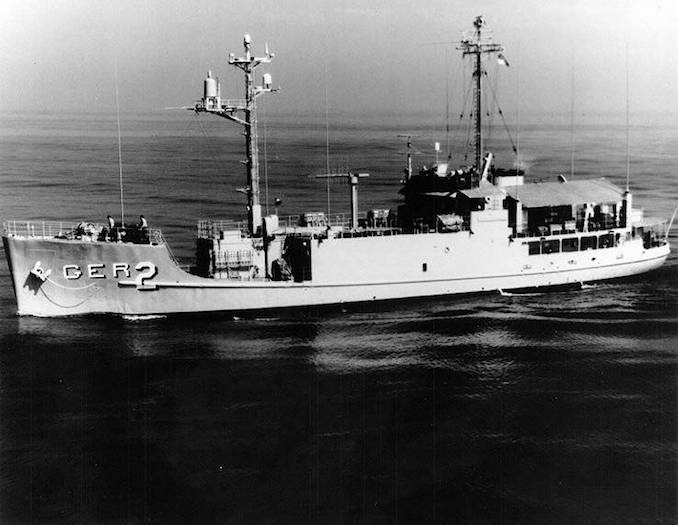
Onboard the USS Pueblo there were a lot of special equipment and equipment for interception and reconnaissance: cryptographic machines such as the KL-47 and KW-7, radio receivers, oscilloscopes, tape recorders, although the ship was closed, the captain tried to drag out time so that the crew could destroy the equipment and documents as ordered by COMSEC.

Koreans tried to take the unarmed Pueblo into the ring, after which they would force them to follow one of the North Korean ports. The pursuit of AGER-2 lasted 2 hours, and then the Koreans took decisive measures - the first shell deprived one of the sailors of the legs, followed by a series of machine-gun shots.

After a direct hit to the mast of 57-mm S0-1 guns, USS Pueblo slowed down and was eventually captured by the Koreans. During the attack, crew member Dwayne Hodges was killed, several sailors were injured. What is interesting the Americans did not destroy the documents and secret equipment, everything was collected into bags (although they should have been thrown overboard), but what is even more surprising they didn’t even turn off the secret equipment.

The ship was taken to the port of Wonsan, and the crew members were shown on North Korean television as part of a propaganda campaign. In the meantime, the equipment was sent for research by North Korean specialists. For several months, Pueblo’s technical staff was being interrogated, the Korean side wanted to understand the principles of operation of the captured equipment.
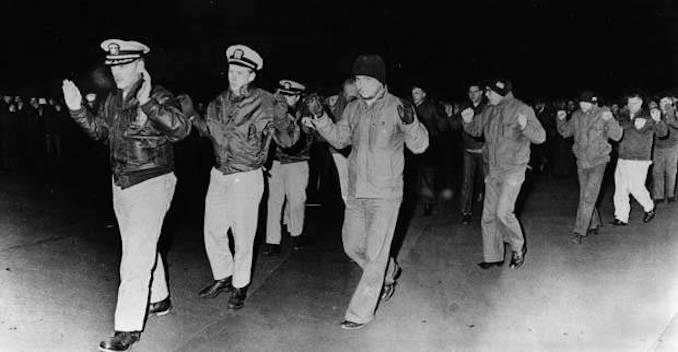
The North Koreans shared their findings with the Soviet Union and even gave them some of the machines to help intercept US communications in the future. After long and tough negotiations between North Korea and the United States, the Americans were forced to admit that the USS Pueblo participated in the espionage mission. Finally, after 11 months of captivity, the crew was released on December 23, 1968. However, the ship remained the landmark of North Korea.
The following list shows which cryptographic equipment was aboard USS Pueblo on January 23, 1968, when it was seized by North Korea. Although the crew seemed to have done “everything possible” to destroy the equipment, part of it was captured intact.
After the crew of the USS Pueblo was released by the North Koreans in December 1968, they were interviewed by the US Navy in order to have a full picture of what equipment was on board and how much of it fell into the hands of the enemy. The final report of this investigation was published several months later, on February 28, 1969. It turned out that the team did everything possible to destroy the equipment and the code material, but some of the machines and parts were captured and (partially) intact.
Of the two KW-7 cipher machines that were on board, only one was properly destroyed. An attempt was made to destroy the second one, but by that time the ship had already been planted by the North Koreans and the car went to the opponents intact. Although this should not have been a problem, because the KW-7 was created according to the principle when the key is secret, and not the equipment itself (according to the Kerkgoffs principle).
Nevertheless, for reasons unknown to the United States, the USSR miraculously had access to a wide range of keys and other crypto devices. And all thanks to John Anthony Walker, who began to spy on the advice in December 1967.
In his book “Spymaster,” a former KGB general, Oleg Kalugin, even suggested that the Pueblo incident could have happened because the USSR wanted to study the equipment described in the documents provided to them by Walker in 1967.
The knowledge gained by the capture of USS Pueblo, in combination with the continuous flow of key material supplied by Walker and his spy group, allowed the councils to decipher over a million US secret messages. Because of this, they were informed and aware of the secret maneuvers and bombings of the US B-52 in Vietnam. Walker, driven by a thirst for money, was probably an American spy who delivered one of the most devastating blows to Americans in Cold War history.
The article used materials from the amazing resource Crypto Museum, Mikhail Voznesensky. “On the verge of a world war. The Pueblo Incident, Hackaday .
Thank you for staying with us. Do you like our articles? Want to see more interesting materials? Support us by placing an order or recommending to friends, 30% discount for Habr users on a unique analogue of the entry-level servers that we invented for you: The whole truth about VPS (KVM) E5-2650 v4 (6 Cores) 10GB DDR4 240GB SSD 1Gbps from $ 20 or how to share the server? (Options are available with RAID1 and RAID10, up to 24 cores and up to 40GB DDR4 RAM).
Dell R730xd 2 times cheaper? Only we have 2 x Intel Dodeca-Core Xeon E5-2650v4 128GB DDR4 6x480GB SSD 1Gbps 100 TV from $ 249 in the Netherlands and the USA! Read about How to build an infrastructure building. class c using servers Dell R730xd E5-2650 v4 worth 9000 euros for a penny?

He is Chrysostom, he's LOSS, he's a fantastic spy system.
1960 year. After the incident with U-2 at the extraordinary session of the UN General Assembly, the American side demonstrated a listening device, which for 8 years was successfully “located” in the Moscow office of the US ambassador and was hidden inside a wooden copy of the Great Press of the USA.

')
The secret bug did not contain any electronic components and did not require batteries or any other power source. Americans christened the bug - the Thing. From the Soviet side, the wiretapping operation was codenamed “Confession”, and the implementation was called “Chrysostom” and was supervised by Stalin and Beria.
The Thing / The item, also known as The Great Seal Bug (a bug in the Great Seal of the United States), was a passive secret wiretap device developed in the Soviet Union and successfully hidden in the office of the American ambassador in Moscow. It was hidden inside the wooden replica of the Great Seal of the United States. Why is a passive device? It worked without its own power source, activated by strong microwave radiation outside. In the US, the device was code-named "LOSS".
For 10 years, the Soviet side carried out painstaking work on the plan to introduce a unique bug. And on August 4, 1945, at the celebration of the 20th anniversary of Artek, the All-Union Pioneer Organization named after Vladimir Lenin presented the United States Ambassador Aveller Harriman a wooden copy of the Great Seal of the United States as a symbol of friendship between the allies in World War II. The coat of arms was hanged in the residence of the American Ambassador Spaso House (Spasopeskovskaya playground).
“Laurenty, have you heard anything about a Trojan horse?”
- Yes, Comrade Stalin.
- Smart people, these Greeks, what do you think? ..
Unknown to Americans, the bug, hidden in the engraved coat of arms, was a high-frequency radio transmitter of the original design: there was no own power source, there were no connections and wires. Instead, the device was driven by a strong radio signal from the outside. Such a resonator with an unlimited duration served the Soviets as the best intelligence service.

Beginning in 1945, after the Amerasia case, the United States was suspicious of security in embassies abroad, especially in Moscow. Although at the end of 1940, quite a few listening devices were found in the US embassies in Eastern Europe, none of them were found in Moscow, beginning in World War II. Nevertheless, diplomats believed that ears had grown on the walls in Moscow. Suspicions intensified in the fall of 1951.

Official version. In 1951, a British radio operator at the British embassy (located 700 meters from the US) watched the Soviet radio connection, when he suddenly intercepted a conversation in which he recognized the voice of the British aviation attaché, but the search at the embassy was not found. Another situation occurred with the American cameraman in 1952, when he accidentally stepped on the LOSS frequency and was able to overhear the conversation, which, as it turned out, was based on the ambassador’s residence at Spaso House. An intensified search for listening devices began. As a result, the bug was discovered with the help of a so-called crystal video receiver, just during the Soviet NKVD interception.
The bug was discovered by the US State Department in 1952 during the time of George F. Kennan, during which time three ambassadors managed to change posts. What they just didn’t do and how they didn’t look for a source of information leakage: the embassy employees were interrogated with a lie detector detector, they shoveled every centimeter of the embassy itself, but to no avail. How did you manage to find Chrysostom in the safe “walls” of a wooden vault? There are several versions: the cessation of information leakage was noticed at the time when the emblem was removed for restoration; cracked wooden coat of arms gave the location of the bug, being in a crack; there was a certain "well-wisher-traitor" Lieutenant Colonel of the GRU Pyotr Popov, recruited by the CIA, sharing secret information.
The crystal video receiver, as the name suggests, consisted of a crystal detector and a video amplifier, the noise level was set by a crystal detector.
The device found inside the coat of arms presented the gaze of Americans in the form of a cylindrical microphone with a wire about 23 cm long, which is interesting, without any batteries. Initially, even there was an assumption that the real bug was hidden in another place, and this is only an unknown thing - The Thing. For another year and a half, American intelligence engineers fought a mystery - what is it? The bug was located under the beak of the eagle, tiny holes made in the tree, sent sound to the membrane. After a successful operation to introduce the device, the Soviet services bought 2 apartments in the building opposite, the residents were immediately evicted and the NKVD employees were accommodated. Thus, Stalin learned about the decisions of Americans before the President of the United States.
The American side decided not to publicize such an unexpected discovery, until the U-2 incident in 1960. On May 1, 1960, an American U-2 spy plane was shot down over the airspace of the USSR. A meeting of the UN Security Council was convened, at which the councils accused Americans of espionage. On the fourth day of the meeting (May 26, 1960) the fact of mutual espionage between the two countries was highlighted: the American ambassador Henry Cabot Lodge demonstrated the Trojan coat of arms.
Device operation
The Thing is a so-called resonant hollow microphone (consisting of a resonant cavity + a condenser microphone). The diagram below shows the construction of The Thing, compiled from various reports and publications.

The silver-plated copper cylinder was a high-quality, reentrantable resonator. In the center there is an adjustable disk-shaped element with a flat surface, which, in combination with a very thin membrane of 75 microns, forms a cavity. The antenna entered the cavity through an insulated hole on the side of the cylinder.
The diameter of the cavity length of 17.5 mm was 19.7 mm, the length of the antenna - 22.8 cm (9 inches). The thickness of the membrane on the front of the cylinder was only 75 microns. Known as endovibrator.

Any sound in the room, such as speech, made the membrane vibrate, which reduced or increased the space inside the cavity, as well as the space between the membrane and the disk-shaped element. As a result, the bug created a combination of amplitude modulation (AM) and frequency modulation (FM).

Receiver overload could be solved by using a directional antenna. To increase the power of the antenna, a 3-pin receive / transmit switch (circulator) was added.

Invention and its author
He creates music from the air
The resonant hollow microphone was patented by Winfield Koch at RCA (Radio Corporation of America) in 1941, while the Soviet bug Zlotoust was developed by Leon Theremin (August 27, 1896 - November 3, 1993). Born in St. Petersburg, the inventor, first of all, he is known as the creator of the electoral music instruments. Theremin or theremin - his brainchild - is a musical instrument with a contactless sensor. During the movement of the hands, the capacity of the oscillating circuit of the instrument changed, which affected the frequency. By the way, you can buy such a tool today at auctions, the price is from 7 thousand dollars.

Theremin lived in the United States since 1927, according to the official version, the councils sent him on a business trip in order to demonstrate what the “technician reached”, although the real purpose of his stay in the United States was espionage. Until 1938, he lived in New York, was known as an extraordinary person, he even married the example of the First American Negro Ballet, for which he paid the loss of many friends and acquaintances, received condemnation in society. He was almost the most popular man in New York, even was listed in the club of millionaires. In his studio worked Albert Einstein, conductor Leopold Stokowski, Charlie Chaplin, Marie Helene Bute and others.
Even after arriving in America, he rented a 99-storey mansion on 54th Avenue for 99 years. In addition to private apartments, it housed a workshop and a studio. Here, Lev Sergeevich often played music with Albert Einstein: a physicist on a violin, an inventor on a Theremin ... He couldn’t even imagine that marrying a dark-skinned woman would radically change his life. But as soon as the lovers registered their marriage, the doors of many houses in New York were closed in front of Termen: America did not yet know political correctness. He lost informers, which caused serious discontent of the Soviet intelligence.
In 1938, due to financial difficulties, he was forced to return to the USSR just before the Second World War. Although there are still versions: according to one, the reason for returning home was his sense of responsibility for his homeland during the impending war; according to the second, the NKVD forcibly removed the inventor.
American friends and acquaintances believed that Theremin disappeared without a trace. The West was convinced that the inventor of the Theremin is dead. Paradoxically, in the USSR, Termen was convicted on suspicion of espionage for 8 years in camps, imprisoned, and later sent to Sharashka, where he served time along with other detained scientists and engineers, such as Andrei Tupolev and Sergei Korolev. There he was engaged in the development of the Buran listening system, The Thing and other devices for the NKVD. In 1947 he was released, and in 1956 he was fully rehabilitated. Until 1966, he continued to work in the NKVD (by that time, the KGB), and after leaving the bodies he was engaged in teaching activities at the Moscow Conservatory, until a journalist from the New York Times published an article about Termen. There was a noise, a sensation "There is life!", As the outstanding inventor was considered long dead. Invitations rained down from all over the world, but it was not there. Instead of fame and recognition of his birthplace, Termen "got" a dismissal from work, his designs were simply thrown away. This is how Termen's synthesizer did not see the light, on which Lev worked painstakingly, which was successfully developed later by Yamaha. He died in 1993 in Moscow at the age of 97 years in poverty in his communal apartment near the Cheryomushkinsky market.
So, after the American U-2 spy plane was shot down over the airspace of Soviet countries on May 1, 1960 (U-2 incident), the Americans decided to open a Soviet listening device called the Western country The Thing / Item that was found in the residence Ambassador to Moscow 8 years ago. Thus confirming the fact that espionage was mutual. Listening device Zlatoust attracted the attention of the international press; over the next days and weeks the headlines about Thing were full on the front pages of newspapers.
There were rumors that the United States did not know how the device worked, and even turned to the UK for help. However, there is a sufficient amount of evidence from official reports about the absence of ignorance on the part of various American agencies: they studied the device and well understood the principle of its work.
The following agencies conducted their own investigations: the US State Department, the FBI, the US Naval Research Laboratory, the NSA, and others.
Although many agencies claim to be involved in the discovery of The Thing, the device was actually found by the State Department (DoS) during an organized secret security check in September 1952. Although endovibrators were already known, they had never been used as listening devices before.
The next day, the find was sent to Washington (USA) and transferred to the FBI for further investigation. Information obtained as a result of studies of the bug, was later used to train various agencies.
As mentioned earlier, the first device research agency after its discovery by the State Department was the Federal Bureau of Investigation (FBI). Determining the operating frequency of the device was not easy, because the FBI equipment was not suitable for frequencies above 400 MHz. Fortunately, the FBI was able to borrow the following test equipment from the National Bureau of Standards (now: NIST) for one day. Important findings of the preliminary study were as follows:
- cavity resonator with built-in condenser microphone
- antenna length 1½λ
- frequency between 1650 and 1800 MHz
- good speech quality
- very sensitive device with a good response range
One of the first organizations that were involved in the investigation, in addition to the Ministry of Defense and the FBI, was the Naval Research Laboratory (NRL), it worked closely with the FBI during a technical investigation. To avoid “duplication” of efforts, the NRL was ordered to develop a counter-receiver that could detect resonant microphones. The laboratory was supposed to provide a working prototype of such a device. On December 1, 1952, the FBI / NRL Final Technical Report was prepared. It was a report on the analysis and experiments conducted by the laboratory and the FBI, detailed large-scale drawings and photographs, an NRL report with schemes for developing equipment for detecting such listening devices.
Since the USSR was the first to use such listening devices, there was a clear understanding that in case of detection of resonant microphones they would be copied by Western agencies and that sooner or later they could be used against them themselves. Therefore, the Soviets developed their own countermeasures.
An example of a receiver that was specifically designed to detect resonant microphones was OSOBNJAK 8.

The device was located in an unobtrusive diplomat and could detect strong near radio frequency signals from 100 MHz to 12 GHz; signals that are commonly used to activate such microphones. The device is also known under the code 1RTA7. The device was powered by rechargeable batteries, which provided approximately 4 hours of battery life.

OSOBNJAK 8 is an example of a device for detecting Malware and similar devices. It is an indicator of field strength (could detect adjacent radio frequency signals between 100 MHz and 12 GHz), divided into 8 frequency bands, each of which has its own antenna. The antennas are hidden inside the case cover, the opening angle is about 90 °. The dimensions of the diplomat made it possible to easily transfer OSOBNJAK 8, take on important meetings, install in every office where important meetings with foreign guests took place, and the device was quite simple to use, and any strong RF microwave signal was immediately detected. With OSOBNJAK 8, it was impossible to determine from which place the radio signal was activated. In order to find where the signal was coming from, we needed an aperiodic receiver for the intended band, plus an antenna with a narrow viewing angle.

A suitable solution is the MRP-4 radar, which was developed in 1972 by Tesla (Czechoslovakia). This device could be carried in a bag, the antennas were directed forward. Although it was originally designed to search for radar stations, it could also be used to detect any nearby strong transmitter. In addition, it could be used to detect weak pulse transmissions from radar and signaling devices.

Antennas MRP-4 had a narrow viewing angle, usually from 1 to 2 degrees, the device was suitable for the frequency range of 1 - 10 GHz, divided into four bands. Similar devices were developed in the USSR.
After the discovery of The Thing in 1952, the CIA began its own research program and development of secret transmitters of this type. In 1965 it was developed
a similar device - a resonant microphone, similar to the Soviet The Thing, activated by a pulse signal.

In 1958, during a joint secret operation of the Central Intelligence Agency (CIA), the Netherlands Internal Security Service (VD) and the Dutch Radar Laboratory (NRP), an attempt was made to deploy a secret listening device (bug) in the office of the Russian ambassador in The Hague (Netherlands) . The operation was called "Easy chair" / Easy hair (EC).

In the early days of the Cold War, both the Dutch Security Service (BVD) and the American Central Intelligence Agency (CIA) regularly conducted secret operations against members of the USSR, and observed Soviet satellites operating in the Netherlands. Since the CIA conducted secret operations in the guest country, it was decided that every action would be taken only with the permission of the BVD.
At the end of September 1958, the BVD reported that the councils ordered new furniture for their embassy in The Hague through the National Procurement Bureau. This chance does not happen often: the opportunity to install listening devices just in the furnishings.
The Dutch BVD developed a plan for installing the Easy Chair (EC) device / Easy Chair - these were manufactured by the Dutch Radar Laboratory (NRP) in Noordwijk (Netherlands) for a top-secret CIA project directly to furniture. So, special attention was paid to the table, since it was intended in the office for the ambassador himself and could in the future show all his “potential”.
On Saturday, November 22, the table was almost ready, it only remained to polish it. This was the perfect time to install the bug, so it was decided that BVD would install the EC the next day, Sunday 23. The next morning, at 11:00, the internal security service of the Netherlands got access to the workshop. The table was turned over, and the bug, without noise and dust, was installed in the left rear corner.

The table was varnished a few days later on November 26, on the same night the BVD operative had to make a small hole 1 mm in diameter again for the microphone, which was blocked during the lacquering. He tested the device, the sound quality was not perfect. A day later, the bug was checked again, the delivery of the table to the embassy was scheduled for December 10, 1958. Meanwhile, the interception point was placed at the observation post Zorgvlid.
Zorgvlid is a fairly tall building, which was located about 125 meters from the front of the USSR Embassy, on the other side of the canal. Although the building was located two streets away from the embassy, the entrance and the front side of the observed object were clearly visible from it.

A few years before these events, the BVD acquired a small room in the attic of the Zorgvlid building, it was monitored, and photo was monitored for those who entered or left the USSR Embassy. Since a clear view of the target building opened in the attic, it became a suitable place to install the Easy Chair antennas. The satellite image shows the position of the observation point Sorgvlid (1958). The interception post was located in a very small room in the eastern corner of the attic, the observation deck was located in an uninhabited part of the building. Behind a few forgotten doors was a small utility room with a narrow staircase, the staircase led to the hatchway, which served as the entrance to the real room for interception. 5 windows of the room (the square of the room approximately 5 x 3 meters) went straight to the Soviet embassy.
Today, the observation post is no longer used. The room is empty, and the view of the embassy is covered with trees. Nothing in the room is any more reminiscent of what happened in its walls during the Cold War.
The images below show how and where the Easy Chair (EC) listening device was built into the furniture. A large mahogany table was ordered to the Soviet embassy, which, most likely (as it was calculated) for the ambassador himself. There are two deep lockers in the table, in each cabinet there are three drawers, closed by doors. The total height of the table was 76 cm. The table was set on a pedestal with a height of 10 cm.

Since the design of the 10 cm pedestal was separated from the main part of the table, it was decided to install a bug in the rear left corner of the table, while a tiny hole with a diameter of 1 mm was made for the microphone, about 6 cm above the pedestal.


A few days after the new furniture was delivered and installed at the USSR Embassy, BVD operatives tried to activate the EU bug, but without success. Presumably, the distance between the target and the interception point was large, or the device was detected.
To check the device at a shorter distance, a truck with a tarpaulin was sent under the embassy, and allegedly something happened to the engine in front of the embassy itself. It was parked in front of the embassy, and under a tarpaulin there was hidden a 40 W transmitter and a battery-powered receiver.

The devices were controlled by field engineer NRP Hextre and the CIA operator, they were in the truck. The antennas were turned toward the embassy, and the transmitter was turned on. After tuning the receiver, after a while they managed to catch the signal of the Easy Chair bug. The first thing they heard was a loud and clear laugh. ES worked and was not detected by the tips. This meant that for the LP antennas the distance from the building where the wiretap was conducted and to the embassy was large.
Two new antennas were developed, each 2 x 2 meters in size and providing a gain of 20 dB, in addition, the isolation between the transmitter and the receiver was improved.
Every day field engineer Hekstra conducted experiments in the attic of the apartment Zorgvlid. His research findings were handed over to Gerhard Prins at the NRP, which took up the improvement of Heckstra's development, and soon after a series of improvements and solutions to EU problems could be reliably activated from the attic.
The operation lasted about six months, after which the bug was discovered by the councils, or perhaps in the attic of the embassy they made a soundproof room.
Easy Chair Bug

Easy Chair (EC) is the name given to a top-secret research project conducted by the Dutch Radar Laboratory (NRP) to the order of the US Central Intelligence Agency (CIA). Easy Chair began to be called a series of secret listening devices (bugs), who saw the world as a result of this study. EU devices are passive devices, they did not need a local power source, such as a battery.
Instead, EC devices were energized from a strong radio frequency (RF) signal transmitted to it from a nearby wiretap point. By the time the tapping operation of the Soviet embassy was underway, the EU was already in its third “incarnation”, using the passive element of the EU III (PE). It is shown in the image below.

Like the previous EC I and EC II, the system ran at 378 MHz, but offered sound masking using a frequency-modulated subcarrier. A new passive element (PE) located inside the antenna was also applied. Thus, the device was improved in terms of secrecy, in earlier EC I and EC II, the signal (in the case of scanning) could be accidentally intercepted.
EC III was one of the first attempts to implement the principle of improving secrecy, known as sound masking. The passive element represented a virtually open vibrator with a length of approximately ½λ. Unlike PE EC I, this version did not need an external amplifier, since its electronics were built into the vibrator. All parts of PE, with the exception of the microphone, were embedded inside the antenna itself.
In addition, PE was suitable for connecting almost any type of high impedance microphones, in the case of the 3-wire version even low impedance microphone was suitable. Another microphone that was used with the EC III and later models was the so-called miniature Type-B. It is based on the RCA BK-6B studio microphone, which was placed in a special case (developed by the CIA).

During the Cold War, the Russian embassy in The Hague, as is known, was engaged in espionage, but everyone worked under the cover of diplomacy. Most of these "diplomats" constantly followed the BVD. In February 1958, three Soviet diplomats were even expelled from the Netherlands. Five NRP employees (a small Dutch company developing equipment) worked directly on the “Soft Chair” operation and subsequent CIA projects. Not the fact that they all knew that their customers are American intelligence services. Moreover, even the Dutch special services did not know about the amount of cooperation between the CIA and the NRP.

Russian Embassy in The Hague (formerly Soviet Embassy)
Information about the operation Easy Chair / Easy chair, which opened completely by accident, shed light on the role of the Netherlands in the Cold War. Maurits Martine (a journalist) conducted an investigation three years long after the grandson of one of the participants in a secret operation had found his grandfather's notes about the CIA and the research being conducted. Cooperation between the NRP and the CIA continued until the 1990s.
USS Pueblo AGER-2
USS Pueblo, also known as AGER-2, was officially a Banner-type hydrographic ship, but in fact it was a Cold War scout and was owned by the US Navy as a information gathering ship (spy ship). He was attacked and captured by North Korean forces on January 23, 1968, after which secret intelligence equipment fell into the hands of North Korea and the USSR. This event is known as the incident that occurred between North Korean patrol ships and the American vessel Pueblo in the territorial waters of North Korea on January 23, 1968.

Reconnaissance vehicle AGER-2. May 13, 1967
On January 5, 1968, Pueblo left the US naval base in Yokosuka (Japan) with the intention of collecting information about the Soviet "red" fleet and North Korea as part of a secret mission with SIGAD USN-467Y, jointly conducted by the US Navy and the US National Security Agency (NSA). For radio contact, USS Pueblo used the call sign Navy on a call to NGVE (November Golf Victor Echo)

On January 22, the ship passed near the North Korean port of Wonsan under harsh radio silence. It was an exceptionally sunny day, the scout quietly moved south along the coast of the Korean Peninsula, collecting information about radio sources simultaneously. After lunch, however, luck turned his back on him; Pueblo was spotted by two North Korean fishing trawlers. The crew decided to break EMCON 3 in order to send a message to SITREP-1, 4, but due to poor ionospheric radio communication, the attempts were unsuccessful.

The next morning at about 10 o'clock SITREP-1 was successfully sent. Shortly thereafter, SITREP-2 was sent, indicating that the vessel was no longer under surveillance, but this was not the case. By lunchtime, a North Korean submarine rapidly approached AGER-2, S0-1 was on the way. Soon, three P4 torpedo boats and two MIG-21 fighters joined.

Onboard the USS Pueblo there were a lot of special equipment and equipment for interception and reconnaissance: cryptographic machines such as the KL-47 and KW-7, radio receivers, oscilloscopes, tape recorders, although the ship was closed, the captain tried to drag out time so that the crew could destroy the equipment and documents as ordered by COMSEC.

Koreans tried to take the unarmed Pueblo into the ring, after which they would force them to follow one of the North Korean ports. The pursuit of AGER-2 lasted 2 hours, and then the Koreans took decisive measures - the first shell deprived one of the sailors of the legs, followed by a series of machine-gun shots.

After a direct hit to the mast of 57-mm S0-1 guns, USS Pueblo slowed down and was eventually captured by the Koreans. During the attack, crew member Dwayne Hodges was killed, several sailors were injured. What is interesting the Americans did not destroy the documents and secret equipment, everything was collected into bags (although they should have been thrown overboard), but what is even more surprising they didn’t even turn off the secret equipment.

The ship was taken to the port of Wonsan, and the crew members were shown on North Korean television as part of a propaganda campaign. In the meantime, the equipment was sent for research by North Korean specialists. For several months, Pueblo’s technical staff was being interrogated, the Korean side wanted to understand the principles of operation of the captured equipment.

The North Koreans shared their findings with the Soviet Union and even gave them some of the machines to help intercept US communications in the future. After long and tough negotiations between North Korea and the United States, the Americans were forced to admit that the USS Pueblo participated in the espionage mission. Finally, after 11 months of captivity, the crew was released on December 23, 1968. However, the ship remained the landmark of North Korea.
Captured equipment
The following list shows which cryptographic equipment was aboard USS Pueblo on January 23, 1968, when it was seized by North Korea. Although the crew seemed to have done “everything possible” to destroy the equipment, part of it was captured intact.
- KL-47
- KW-7
- KWR-37
- KG-14
After the crew of the USS Pueblo was released by the North Koreans in December 1968, they were interviewed by the US Navy in order to have a full picture of what equipment was on board and how much of it fell into the hands of the enemy. The final report of this investigation was published several months later, on February 28, 1969. It turned out that the team did everything possible to destroy the equipment and the code material, but some of the machines and parts were captured and (partially) intact.
Of the two KW-7 cipher machines that were on board, only one was properly destroyed. An attempt was made to destroy the second one, but by that time the ship had already been planted by the North Koreans and the car went to the opponents intact. Although this should not have been a problem, because the KW-7 was created according to the principle when the key is secret, and not the equipment itself (according to the Kerkgoffs principle).
Nevertheless, for reasons unknown to the United States, the USSR miraculously had access to a wide range of keys and other crypto devices. And all thanks to John Anthony Walker, who began to spy on the advice in December 1967.
In his book “Spymaster,” a former KGB general, Oleg Kalugin, even suggested that the Pueblo incident could have happened because the USSR wanted to study the equipment described in the documents provided to them by Walker in 1967.
The knowledge gained by the capture of USS Pueblo, in combination with the continuous flow of key material supplied by Walker and his spy group, allowed the councils to decipher over a million US secret messages. Because of this, they were informed and aware of the secret maneuvers and bombings of the US B-52 in Vietnam. Walker, driven by a thirst for money, was probably an American spy who delivered one of the most devastating blows to Americans in Cold War history.
The article used materials from the amazing resource Crypto Museum, Mikhail Voznesensky. “On the verge of a world war. The Pueblo Incident, Hackaday .
Thank you for staying with us. Do you like our articles? Want to see more interesting materials? Support us by placing an order or recommending to friends, 30% discount for Habr users on a unique analogue of the entry-level servers that we invented for you: The whole truth about VPS (KVM) E5-2650 v4 (6 Cores) 10GB DDR4 240GB SSD 1Gbps from $ 20 or how to share the server? (Options are available with RAID1 and RAID10, up to 24 cores and up to 40GB DDR4 RAM).
Dell R730xd 2 times cheaper? Only we have 2 x Intel Dodeca-Core Xeon E5-2650v4 128GB DDR4 6x480GB SSD 1Gbps 100 TV from $ 249 in the Netherlands and the USA! Read about How to build an infrastructure building. class c using servers Dell R730xd E5-2650 v4 worth 9000 euros for a penny?
Source: https://habr.com/ru/post/374349/
All Articles